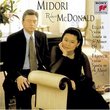| All Artists: Borodin, Rpo, Ashkenazy Title: Symphony Nos 1 & 2 Members Wishing: 0 Total Copies: 0 Label: Decca Import Release Date: 4/4/1994 Album Type: Import Genre: Classical Styles: Forms & Genres, Symphonies, Symphonies Number of Discs: 1 SwapaCD Credits: 1 UPC: 028943665124 |
Search - Borodin, Rpo, Ashkenazy :: Symphony Nos 1 & 2
 | Borodin, Rpo, Ashkenazy Symphony Nos 1 & 2 Genre: Classical
|
Larger Image |
CD DetailsSimilar CDs
Similarly Requested CDs
|
CD ReviewsAshkenazy Conducts Borodin with Great Dignity Grady Harp | Los Angeles, CA United States | 09/16/2005 (5 out of 5 stars) "The transition from piano soloist to conductor has been a successful one for Vladimir Ashkenazy. His intuitive approach to internal phrasing brings out some of the more subtle qualities in these particular romantic symphonies. The Royal Philharmonic Orchestra responds sensitively to his demands and the recorded sound from the EMI studios and London halls is excellent. Other conductors may conduct both Symphony 1 and 2 with more drama than Ashkenazy commands, but the works bear their hearts on their sleeves and for once it is nice to hear the nuances of Borodin's writing rather than the romantic swoop that inspired Kismet! Also included on this album is a sensitive reading of 'In the Steppes of Central Asia', again performed with more clarity than other conductors obtain. For those without recordings of the Borodin symphonies this CD is a fine starting point. Grady Harp, September 05" Hot-blooded Russian Music Brett A. Kniess | Madison, WI | 04/15/2000 (5 out of 5 stars) "Alexander Borodin was part of a group called the Moguchaya Kuchka or the Mighty Handful, five Russian composers dedicated to raising the standards of Russian national classical music. The movement flouted Russian folk-music elements such as tunes, rhythms, modes, and instrumentations from their homeland. Borodin followed in this model, although he was the amateur of the group while pursuing his career as a scientist. This disk features some of his popular concert works: his Symphonies No. 1 & 2, as well as the famous symphonic poem, In the Steppes of Central Asia. Russian exoticism permeates In the Steppes of Central Asia. The searing heat is depicted from beginning to end by using harmonics on the violins, and a traveling caravan is heard by a modal melody on English horn. As the caravan approaches and the viewer watches the military detail accompanying the caravan, a grand melody enters and the orchestra swells until they pass and fade away, all on a positive note, leaving only the sounds of the desert. A very colorful miniature. The First Symphony is often called Borodin's "Eroica" because of the similar orchestra hits from Beethoven's Third Symphony. In four movements, the first and last movements have great energy and vigor. Both contain an almost jazzy syncopated melody and/or accompaniment, often reminding me of Gershwin, while the rhythmic vitality is indicative of Copland. The colors, however, are obviously Russian, also seen in the fleet-footed scherzo of the second movement. It has a fantastical feeling with great light writing across the orchestra sections; the trio section counters with a Romantic sweep before the return of the opening whimsy. A quintal chord stacking opens the Andante third movement, before a yearning and emotional cello romance begins; quick ornamentations and a simple melody give a folk sound, and when the full ensemble takes over, the colors come alive. The final movement seems off-kilter in its second section, but a heroic mood brings the work to a close. Borodin's Second Symphony tries to recall the chivalry of his Russian ancestors, and it is apparent from the beginning; a bold unison melody, all down-bowings, seems elemental and angry. A more pleasant "B" section is more playful, but the powerful strings and brass overpower from the forcefulness of the opening. The tragedy of the first movement is carried over onto the first chord of the second movement, but is soon quelled by a zippy scherzo in major with quick repeated brass notes, not to mention the romantic warmth of the trio section and the eventual return of the fast scherzo. The wonderfully beautiful opening of the third movement andante for solo horn, harp, and strings is romantically breathtaking, an emotional calm before the ambiguous sounding and crabby second section. The final movement's Copland-esque rhythmic vitality is inherently good-natured, innocent, and fun; despite a brief moody, medieval jaunt, a rollicking good time is had through the end of the symphony; certainly some of the best and most exciting parts Russian literature exist in this movement. The music is colorful and exciting, and the energized feeling is brought out by Vladimir Ashkenazy and the Royal Philharmonic Orchestra. While they are not perfect here, they passionately perform this Russian music and dig in with articulation and musicality. Ashkenazy, well-known as a pianist, has an early conducting attempt here, and a successful one at that. The London sound is full and dynamic, aiding the truly red-blooded performances. At 70 minutes, interesting nationalistic music and Borodin's famous symphonic works are brought to life. An excellent buy if you can find it." Smashing Borodin Micromegas | Ada, OK | 03/22/2007 (5 out of 5 stars) "I have purchased (and in some cases, sold) every single version of the Borodin symphonies on CD. Borodin's symphonies are strange creatures, in that they "sound" so incredibly spontaneous and gorgeous, and yet, sometimes they don't really take off; in other words, they often sound like colorful suites without any real symphonic proportions or purpose. Several fine versions of No.2, such as Kubelik's and Ansermet's, don't really convince me that this is a first-rate symphony, just generally good music. Ashkenazy's is one of the few versions that makes this music great music and symphonic music.
If nothing else, he makes a resounding case for the neglected First Symphony, which is little short of genius. It is cut very much from the same cloth as other First Symphonies in the 'Mighty Handful': Balakirev's First (who advised Borodin and initially made many "corrections" which Borodin later excised) is a clear model, as is Rimsky's First. While I think Balakirev's is ultimately the strongest of the three Firsts, Borodin's is the most lyrical and inviting: you want to live in this world over and over again, as its melodies are rich and seductive in the best "Oriental" sense of Russian Romanticism. The first movement is powerful and expansive, yet without making an epic statement; the second is a charming scherzo (very much like Balakirev's 1st) with an achingly beautiful trio. But the slow movement is heavenly--one of his greatest, most inpsired creations, and even, if possible, more beautiful than that of No.2. It seems to come out of nowhere, or at least, from the very depths of old world melodies and folksongs. It's timeless and beautiful, and it is scored to perfection (interestingly, this is one of Borodin's only works that was not touched up by Rimsky or Glazunov). The finale is a jaunty dance-like piece that sounds slightly Polovistian, and is extremely memorable. A fascinating piece that rightly won Liszt's admiration in its day. The Second is much more well known, but Ashkenazy manages to make it sound new, fresh, and exciting. The opening theme of the first movement is the big test for me--it can sound pompous, melodramatic, or like a non-event rather than the exciting, dramatic theme that it is. Ashkenazy really lets it rip, not taking it too fast (as many do), but letting it breathe and resonate. It sounds rich and portentous--like the opening of an ancient Russian epic. Every moment is beautifully calculated to my ears, and really comes off--not least of which the delicious Scherzo, possibly my favorite Borodin symphonic movement (which I remember a critic saying didn't fit in the symphony!). In short, an amazing interpretation and assessment of Borodin's lyric and symphonic gifts. Even if you have many recordings of the work, add this one to the pile--you'll quickly forget most of them. Oh--and a great version of In the Steppes of Central Asia as well." |

 Track Listings (9) - Disc #1
Track Listings (9) - Disc #1












